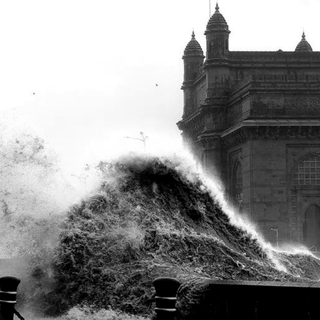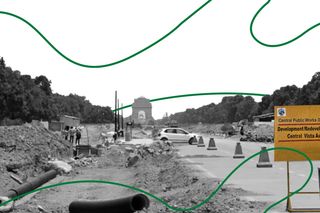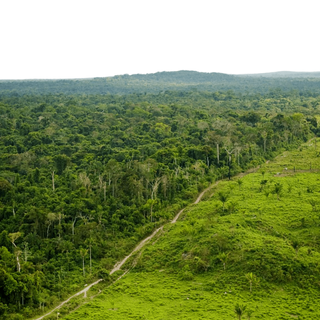
Why Delhi’s Central Vista Project Has Sparked Debate About Development, Heritage
The redevelopment is taking place during the pandemic at a significant economic cost — uprooting heritage and forest cover in the process.

In the midst of India’s second Covid19 wave, the central government is fighting to continue one essential service — the construction work around Central Vista in New Delhi. The project envisions a new and improved Lutyens’ Delhi, transforming the stretch of land between Rashtrapati Bhavan and India Gate in the next five years.
Criticism against the project has taken note of the scale of expenditure — a hefty cost of Rs. 20,000 crore — as well as the intent — with many calling it a veritable “vanity project” by the ruling Bharatiya Janata Party (BJP). It is also the timing of the project, in the midst of a pandemic that has pushed India’s healthcare system to the brink, that makes this specter of “redevelopment” seem unnecessary and extravagant.
The central government’s justification has perched on two arguments: Central Vista is India’s “power corridor” and thus must reflect power itself; the current structures are far too dilapidated and congested, requiring repairs worth millions in itself, along with a shortage of parking space.
The project is elaborate but can be broken down into four phases. First is the construction of a new triangle-shaped parliament building, the foundational stone for which was laid by the Prime Minister last December. What will happen to the current parliament building? It will be turned into a “museum of democracy.” Second, 11 existing buildings, including heritage sites like the National Museums and the Indira Gandhi National Centre for the Arts (IGNCA), are set to be demolished. Third, the verdant green lawns alongside Rajpath will be transformed into land for seven-story high bureaucratic offices. Fourth, construction of new residences and an office block for the Prime Minister and Vice President of India will take place by 2022 — the environmental clearance for which was granted earlier this month. The North and South Block of Lutyens’ Delhi, which currently houses government ministries will turn into museums, while those ministries will shift into the new office blocks.
The renovation aspires to be a celebration of “democracy” and “development” — two terms that have come to mean different things to the state and its people.
Related on The Swaddle:
More Green Spaces in Cities Could Help Prevent Early Deaths, According to Research
Various petitions and appeals have been made against carrying out the project during the pandemic. “It is especially troubling that this extravagant project is moving ahead in the midst of a devastating pandemic,” said an open letter addressed to the Prime Minister by a group of more than 70 scholars from India and abroad, including historian Romila Thapa and critic Gayatri Spivak. “The current escalating health crisis calls for a pause and a reset. In the short term, all priorities and resources should be directed at combating the pandemic,” signatories noted, calling for a halt and reconsideration of the government’s project.
Other concerns include the safety of construction workers, who stand the risk of contracting the infection. The national capital is currently in lockdown owing to a sharp rise in cases, but the Central Vista work is continuing as an “essential service” — as designated by the Supreme Court — and continues work in full swing, housing laborers at the site itself or ferrying them from their homes. Recently, the Delhi police put up notices of “no photography” and “no video recording” along with the redevelopment site, prompting concerns regarding the health risk and poor working conditions being concealed.
A petition in the Supreme Court noted the “super spreading potential and threat” posed by the construction work. “When we came to your lordships, we were afraid their dereliction was going to lead to an Auschwitz on the gardens of Central Delhi, on the gardens of India Gate,” senior advocate Siddharth Luthra argued.
Others too have drawn historical concerns. “As history has it, Nero wanted to rebuild Rome in a more modern and contemporary fashion. His ministers, however, refused to let that happen. All of this, while the rest of his empire was still coping, trying to survive with what little they had left,” Seraj Ali writes in The Wire. In a pandemic age, the burning of Rome unerringly becomes a euphemism for India’s crisis. The transporting of these rare manuscripts, books, and Mughal-era documents from these buildings is fraught with the risk of loss and mishandling
Union Minister Hardeep S. Puri argued that the money allocated for Covid19 vaccines — Rs 35,000 crores — is more than what has been spent on the Central Vista over the years. This, however, doesn’t negate the reality of a ferocious second wave — overflowing crematoria, corpses in rivers, patients dying due to lack of oxygen among other resources. Critics have pointed to the need to spend more on healthcare infrastructures and socio-economic forces, rather than beautification projects that become an eyesore during a crisis.
Apart from the costs, lack of transparency and contracts, hurried approvals, lack of public and expert consultation have also drawn criticism. The revamp also reframes the development versus environment binary. The project received a green light without an environmental impact study (as is routine for plans of this scale), despite over 1,200 objections. The construction activity will black the watershed between the Ridge Forest to the Yamuna bank, leading to flooding. The felling of trees raises concerns of pollution — Central Delhi, even with its current open spaces and tree cover struggles to absorb the sharp level of air pollution. Urban planners have also expressed concern about the impact of housing more than 7,000 bureaucrats within one premise — which will increase traffic, congestion, and pollution levels.
The scholars who urged the government to cease the construction also noted in their letter of the heritage loss that comes with the redevelopment. “There should be public consultations so that the future of India’s institutions, heritage architecture, and historical collections can be determined through a democratic process… It is unclear, for example, how the National Museum art objects will be stored and eventually displayed.” Iconic structures such as the National Museum house rare idols, heritage pieces, sculptures, maps, documents. Under the current plan, they will be shifted to new homes, but the concern of mishandling and breakage remains.
The government on its part says all listed heritage buildings will be protected — and renovation work will continue after approval from the Heritage Conservation Committee. “It [the claim] is wrong because it [the government] is conserving a few buildings and that also the skeletons of the buildings. So in other words, what they’re doing is the heritage is being conserved by conserving the building but hollowing out its meaning,” A.G. Krishna Menon, an architect and conservation consultant, told NDTV.
Author and historian Swapna Liddle also tells Al Jazeera that “the building materials like sandstones, the chhatri (dome-shaped pavilion) and chhajja (overhanging eave), the stupa-like build of the president’s house are very Delhi in their heritage.” The project then is set to obliterate historical aspects of a city in the name of aesthetic merit.
Related on The Swaddle:
Podcast: Dr. Harini Nagendra On Using Ecological Imagination to Build Sustainable Indian Cities
The government has also cited culture as a reason for the renovation project, arguing that Lutyens’ Delhi, built by British architect Edwin Lutyens is a colonial relic; revamping this site is then an exercise in nationalism and reclaiming Indian heritage. But historians have pointed out the fallacy in this argument. “The colonial history of the Vista lasted only 17 years. It is important to point this out because the structures destroyed or slated for demolition are all postcolonial, built by a free Indian state between the 1950s and 2011,” historian and author Narayani Gupta told Al Jazeera. “None of them are ‘symbols of colonial oppression,'” she says, adding it’s all about “real estate and building contracts.”
The project has started to pick up pace — visuals from Rashtrapati Bhavan show trenches dug deep behind yellow barricades. Arguably, one of the most notable impacts of the project is on people and neighboring communities. Projects like Central Vista represent a modern, urban growth, which with their rapidity threaten access to housing, water, sanitation, electricity, public transport, education, and health care for vulnerable communities, like those living in bastis and urban slums. For them, this reignites the issue of affordable housing and identity, where forced eviction in the name of “development” segregates them from the larger conversation.
Moreover, the Rajpath stretch, which is soon going to have edifices erected over it, exists as an urban common. As a public space, it allows access and engagement — offering refuge, a space for resistance, or merely existing. Putting it behind barbs and fortifying it excludes people, changing their relationship with the national capital, and their nation. “If government buildings are imposing, far away from the street or hidden behind walls, they propagate a culture of people seeing their government as imposing, distant, far from them and even hidden,” architect Rajeev Bhakat tells The Wire.
The Central Vista project “usurps the most important public, green and recreational sites of the city, and in an unprecedented land-use change seeks to transfer public land use to the state to house the highly fortified government functions,” Amritha Ballal argues in Scroll.in. This not only jeopardizes public access but also makes cities at risk of losing traditional knowledge, believed to be critical in promoting inclusiveness, sustainability, and resilience, urban experts say.
This architectural vision insists on bifurcating the national capital into neatly laid out parts seemingly for a “greater good”; but Lutyens’ Delhi exists as a composite whole, a marker of identity and belonging. Historian Ramachandra Guha sums it well: a “museum of democracy” is an apt phrasing for the project, “this is grimly appropriate, since Museums are for things that are dead or extinct.”
Saumya Kalia is an Associate Editor at The Swaddle. Her journalism and writing explore issues of social justice, digital sub-cultures, media ecosystem, literature, and memory as they cut across socio-cultural periods. You can reach her at @Saumya_Kalia.
Related


Earth’s Atmospheric Layer is Shrinking Because of Carbon Emissions, Scientists Find
